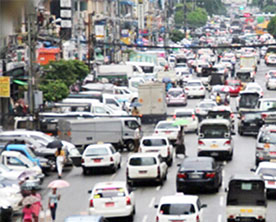Deteriorating traffic congestion is an inescapable condition in Yangon. Peakhour traffic congestion is an inherent result of the way modern societies operate. It stems from the widespread desires of people to pursue certain goals that inevitably overload existing roads and transit systems every day. But everyone hates traffic congestion, and it keeps getting worse, despite attempted remedies. Commuters are usually frustrated by policymakers’ inability to do anything about the problem, which poses a significant public policy challenge. Governments may never be able to eliminate road congestion in rush hours. Passengers hate waiting for ages in crawling cars but they can do nothing apart from groaning inwardly. Even if fare boxes on all YBS bus lines are installed, they are inconvenient for passengers because bus conductors are unavailable to give change and some passengers do not have a 200-kyat note and a 100-kyat note for bus fares. YBS needs to swiftly implement the card pavement system for handling this issue.
Real Issues
Traffic congestion is the main problem. Efficient, reliable and affordable public transport is fundamental to our quality of life. In fact, traffic congestion is the worst in Yangon. More and more cars are being imported into Yangon from foreign countries every day. The number of vehicles has been increasing from over four million in 2013 to over six million in 2017. Now Yangon is full of traffic-clogged roads and streets. Buses are crammed full of passengers. Heavy monsoon rain causes widespread flooding in Yangon. It leads to frustrating traffic jams with vehicles moving at a snail’s pace.
Solving the Problems
Governments have to charge people who enter all the lanes on major commuting roads during peak hours. If tolls are set high enough and collected electronically with “smart cards,” the number of vehicles on each major road during rush hours can be reduced sufficiently so that vehicles can move at reasonable speeds. That will be able to allow more people to travel per lane per hour than under current, heavily congested conditions.
If enough road capacity is to be built for handling all drivers who want to travel in peak hours at the same time without delays, governments wouldhave to widen all major commuting roads by demolishing buildings, cutting down trees, and turning most of every suburb areas into a large concrete slab. Those roads then become underutilized during non-peak hours. There are many occasions when adding more road capacity is a good idea, but no large region can afford to build enough to completely eliminate peakhour congestion.
Public transport capacity would be expanded enough for shift so many people from cars to public transport, there would be no more excess demand for roads during peak hours. In Yangon, approximately 2.8 million commuters catch Yangon Bus Service (YBS) as a form of public transport each day. Yangon suburb areas with the most daily commuters account for 80 percent of all YBS commuting. Only 20 per cent of all commuters use their cars. There are many good reasons to expand Yangon’s public transport systems to aid mobility, but doing so will not notably reduce either existing or future peakhour traffic congestion. Government is to give the first priority to traffic issues. A study described the Yangon Bus Service (YBS) has experienced difficulties for its new bus system due to inefficient management in the proliferation of routes, inadequate bus networks, and lack of financial support. A survey shows that if a road is part of a larger transportation network within a region, peak-hour congestion cannot be eliminated for long by just expanding that road’s capacity.
If a certain number of workers are able to commute during non-peak hours of the day that will free up space on formerly congested roads. Traffic moves faster on those roads during peak hours that will attract other drivers from other routes, other times, and other modes where conditions have not changed to shift onto the improved roads. The same thing will happen if more workers become telecommuters and work at home, or if public transport capacity is expanded on off-road routes that run parallel to a congested expressway. But it will not happen immediately for a developing country. It will take more time.
If Yangon’s population is growing rapidly, more vehicles generated by the added population may soon swamp any expansions of major expressway capacity. It will add fuel to the fire. The population of Yangon in 2017 is estimated to be 7.4 million. Yangon’s human population is expected to grow by around 8 million by 2020. At present, over 2 million people are mostly depending on the YBS in Yangon where 6.2 million people are residing. Prospects for reducing peak-hour traffic congestion in the future are dim indeed. Shifts in economic activity also affect regional congestion. Due to the abundant cars boom, traffic congestion in Yangon keeps intensifying daily. Severe congestion can be a sign of strong regional prosperity, just as reduced congestion can signal an economic downturn. Yangon Region Chief Minister Phyo Min Thein has been conducting surveys on the public transportation system with cooperating of the regional government for ease of traffic jams in Yangon. Government is to implement Intelligent Transportation Systems (ITS) for the better management of the transport networks as well as for providing services for travellers like other developing countries. ITS has been widely implemented around the world not only to reduce congestion by providing traffic flows on transportation networks, managing the demand, and diverting the demand for car travel to other modes of transport but also to enhance safety through faster emergency response, better incident detection and management, enforcement of speed limits and red light violations, and anti-collisions and enhance vision systems.
The most obvious reason traffic congestion has increased everywhere is vehicles’ rapid growth without a comparable increase in transportation infrastructure. In a developed nation, more people mean more vehicles. But total vehicle mileage traveled has grown much faster than population. Another factor in road congestion is accidents and incidents, which some experts believe cause half of all traffic congestion. From 2013 to 2016, the absolute number of accidents each year has remained amazingly constant, and the annual number of traffic deaths in Yangon soared nearly 40 per cent due to the great rise in vehicle numbers. So accidents may cause more congestion because roads are more crowded, and each accident may now cause longer back-ups than before. Incidents are non-accident causes of delay, such as stalled cars, road repairs, overturned vehicles, unskilled drivers, high-speed driving, reckless driving, the consumption of alcohol and drugs. A number of incidents keep rising because drivers consume a lot of alcohol and then drive recklessly on the roads.
Finding Solutions
While it’s practically impossible to eliminate congestion immediately, there are several ways to slow its future rate of increase. Respond more rapidly to traffic-blocking accidents and incidents. Government has to operate Traffic Management Centers (TMC) widely for handling of traffic congestion and removing accidents and incidents from major roads faster by using roving service vehicles equipped with television and electronic surveillance of road conditions is an excellent tactic for reducing congestion delays. Government should build more expandable roads in growing areas. Letting vehicles enter expressways only gradually is better for freeway speed during peak hours in Yangon.
Urban growth boundaries that severely constrain all far-out suburban development will not reduce future congestion much, especially in fast-growing regions. And such boundaries may drive up peripheral housing prices. Raising gas taxes would notably slow the rate of increase of all automotive travel, not just peak-hour commuting. Peak-hour traffic congestion in almost all large and growing metropolitan regions around the world is here to stay. In fact, it is almost certain to get worse during at least the next few decades, mainly because of rising human and car populations. This will be true no matter what public and private policies are adopted to combat congestion. But this outcome should not be regarded as a mark of social failure or misguided policies. Indeed, traffic congestion often affects economic prosperity and other types of success.
Although traffic congestion is inevitable, there are ways to slow the rate at which it intensifies. Several tactics could do that effectively, especially if used in concert with, but nothing can eliminate peak-hour traffic congestion from large metropolitan regions here and around the world. Only serious economic recessions—which are hardly desirable—can even forestall an increase. For the time being, the only relief for traffic-plagued commuters is a comfortable, air-conditioned vehicle with a well-equipped stereo system, a hands-free telephone, and a daily commute with someone they like. Now Yangon’s traffic congestion has become part of commuters’ daily leisure time, and it promises to stay that way.










